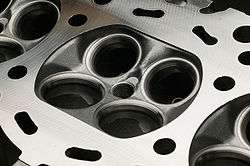Pent-roof combustion chamber

In engine design, the penta engine (or penta head) is an arrangement of the upper portion of the cylinder and valves that is common in engines using more than two valves per cylinder. It is similar in concept to the hemi engine, both in design and purpose, but a hemispherical cylinder head is limited to only two valves without the use of a more complex sub-rocker assembly. Thus penta designs tend to be more efficient.
The four-valve penta engine design was invented by Peugeot of France, to be first used in the 1911 Indianapolis 500 race.
The penta engine (also termed pentroof combustion chamber) is the most common design used today by many manufacturers for four-valve-per-cylinder engines producing relatively high horsepower for displacement, for both racing engines and engines for passenger cars.